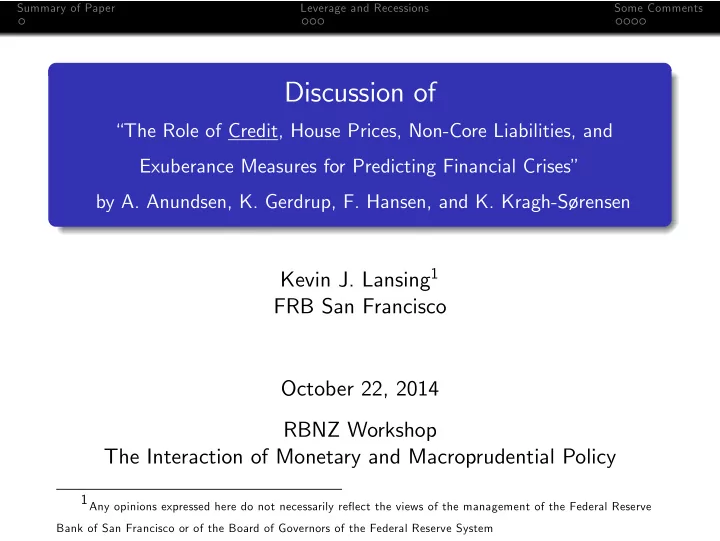

Summary of Paper Leverage and Recessions Some Comments Discussion of “The Role of Credit, House Prices, Non-Core Liabilities, and Exuberance Measures for Predicting Financial Crises” by A. Anundsen, K. Gerdrup, F. Hansen, and K. Kragh-Sørensen Kevin J. Lansing 1 FRB San Francisco October 22, 2014 RBNZ Workshop The Interaction of Monetary and Macroprudential Policy 1 Any opinions expressed here do not necessarily reflect the views of the management of the Federal Reserve Bank of San Francisco or of the Board of Governors of the Federal Reserve System
Summary of Paper Leverage and Recessions Some Comments What variables help to predict financial crises? Authors estimate a multivariate logit model of crises probability to give early warning signal up to 3 years ahead. (27 total crisis episodes in panel).
Summary of Paper Leverage and Recessions Some Comments What variables help to predict financial crises? Authors estimate a multivariate logit model of crises probability to give early warning signal up to 3 years ahead. (27 total crisis episodes in panel). Multivariate extension of Drehmann, Borio, and Tsatsaronis (IJCB 2011). Nevertheless, the Credit/GDP gap alone appears to predict crises just as well in out-of-sample forecasting exercises.
Summary of Paper Leverage and Recessions Some Comments What variables help to predict financial crises? Authors estimate a multivariate logit model of crises probability to give early warning signal up to 3 years ahead. (27 total crisis episodes in panel). Multivariate extension of Drehmann, Borio, and Tsatsaronis (IJCB 2011). Nevertheless, the Credit/GDP gap alone appears to predict crises just as well in out-of-sample forecasting exercises. Household Credit/GDP gap is a more important predictor of crises (in-sample) than Business Credit/GDP gap.
Summary of Paper Leverage and Recessions Some Comments What variables help to predict financial crises? Authors estimate a multivariate logit model of crises probability to give early warning signal up to 3 years ahead. (27 total crisis episodes in panel). Multivariate extension of Drehmann, Borio, and Tsatsaronis (IJCB 2011). Nevertheless, the Credit/GDP gap alone appears to predict crises just as well in out-of-sample forecasting exercises. Household Credit/GDP gap is a more important predictor of crises (in-sample) than Business Credit/GDP gap. Inclusion of Global Credit/GDP gap improves in-sample fit of model. “A tree’s risk of catching fire is usually small, except when the forest is ablaze.” —Jorda (IJCB 2011).
Summary of Paper Leverage and Recessions Some Comments What variables help to predict financial crises? Authors estimate a multivariate logit model of crises probability to give early warning signal up to 3 years ahead. (27 total crisis episodes in panel). Multivariate extension of Drehmann, Borio, and Tsatsaronis (IJCB 2011). Nevertheless, the Credit/GDP gap alone appears to predict crises just as well in out-of-sample forecasting exercises. Household Credit/GDP gap is a more important predictor of crises (in-sample) than Business Credit/GDP gap. Inclusion of Global Credit/GDP gap improves in-sample fit of model. “A tree’s risk of catching fire is usually small, except when the forest is ablaze.” —Jorda (IJCB 2011). Authors construct country-specfic “exuberance measures” to indicate explosive behavior in: (1) House Price/Income or (2) Credit/GDP. These variables improve in-sample fit of model but not much help in out-of-sample forecasts.
Summary of Paper Leverage and Recessions Some Comments Leverage magnifies the severity of recessions Source: IMF World Economic Outlook (2009), Chapter 3. "Over-investment and over-speculation are often important; but they would have far less serious results were they not conducted with borrowed money." – Irving Fisher (Econometrica, 1933, p. 341)
Summary of Paper Leverage and Recessions Some Comments Leverage magnifies the severity of recessions Source: IMF World Economic Outlook (2009), Chapter 3. "Over-investment and over-speculation are often important; but they would have far less serious results were they not conducted with borrowed money." – Irving Fisher (Econometrica, 1933, p. 341) House Price Stock Price Data from 21 countries, 1970 to 2008 Busts Busts Total number of busts 47 98 Mean number of busts per country 2.8 4.7 Mean price decline per episode -18% -37% Mean duration of episode 10 qtrs 7 qtrs Mean decline in GDP per episode 1 -4.3% -1.3% 1. Relative to GDP trend.
Summary of Paper Leverage and Recessions Some Comments More household leverage makes recessions worse Sources: M. King (EER 1994) and R. Glick and K.J. Lansing (FRBSF EL 2010).
Summary of Paper Leverage and Recessions Some Comments Debt-to-income (DTI) versus Loan-to-value (LTV) ratios DTI was an early warning signal of the dangerous buildup in U.S. household leverage.
Summary of Paper Leverage and Recessions Some Comments What about Investment/GDP as a predictor variable? Borio and Lowe (2002): “Periods of strong credit growth, booming asset prices, and high levels of investment almost invariably lead to stresses in the financial system.” Real Business Investment and Real S&P 500 Index Real Residential Investment and Real House Price Index (each series normalized to 100 at the investment peak) (Each series normalized to 100 at the investment peak) 1 4 0 110 Real Business Investment 100 1 2 0 90 1 0 0 Real Residential Investment 80 8 0 70 6 0 60 Real S&P 500 Index 4 0 50 Real S&P Case-Shiller Price Index 2 0 40 95 96 97 98 99 00 01 02 03 04 05 06 07 08 09 95 96 97 98 99 00 01 02 03 04 05 06 07 08 09
Summary of Paper Leverage and Recessions Some Comments Credit/GDP gap alone beats multivariate model What about Household Credit/GDP gap alone?
Summary of Paper Leverage and Recessions Some Comments Har vi en boligboble i Norge? Norwegian ratios are well above the last major peak observed in late 1980s. House Price/Income Mortgage Debt/Income
Summary of Paper Leverage and Recessions Some Comments Exuberance measures: Norway vs. U.S. Why are Norway’s exuberance measures so low? Why not compute household credit exuberance? Jorda, Schularick, Taylor (2011): No 2008 crisis in Norway.
Recommend
More recommend